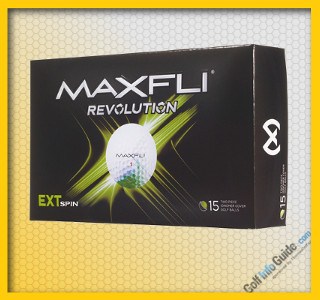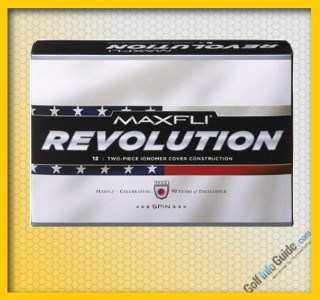
Ball tested: Maxfli Revolution Spin
Category: Value/Recreational/Distance
Feel: Soft
Tested for golfers with average driving distance of: 125 yards or less (carry + roll) / 126 to 195 yards (carry + roll) / 196 to 245 (carry + roll)
Specs: Construction – Two-piece; Cover – Ionomer; Core – Mid-compression; Dimples – 392
Compression: Mid
Price as tested (new): $19.99 per dozen
Ball notes: Think of the Maxfli Revolution Spin golf ball as the “poor man’s” version of the company’s U/4 model.
Granted, the balls are completely different in construction and cost, not to mention the marketing effort parent company Dick’s Sporting Goods puts behind them. But the Revolution Spin promises the same high-spin performance as its cousin, at $15 less per dozen. (Keep in mind that Dick’s and its offshoot, Golf Galaxy, have been known to sell the Revolution series for half the retail price.)

Maxfli differentiates the Revolution Spin from the Revolution Low Compression by giving the former a firmer core, higher overall compression and a softer cover. Let’s see if our testing revealed any major separation between the two.
On the clubface: Before we even put the ball on a tee, we noticed something unusual about the Revolution Spin – its surface felt softer and tackier than your average ionomer-covered ball. That immediately raised our expectations for feel, and this Maxfli met them. While it’s not quite as soft as the Low Compression model, Spin offers excellent squeeze off the clubface with the driver and irons, as well as the putter.
Off the tee: Driver in hand, we were prepared to watch this ball fall somewhat short of its sibling and other two-piece models. We were pleasantly surprised, then, when Spin held its own in the distance department. It launched high with less yardage-killing backspin than we anticipated. Better yet, the extra spin came in handy when a fade or draw was called for.
From the fairway / rough: The million-dollar question: Would Spin deliver what its name promised where it’s really needed? The surprisingly affordable answer: Yes, indeed. The ball exhibited stop-and-hop action comparable to two-piece, value-priced competitors as well as multi-layer “premium” offerings. The Revolution Spin carried with ample height on hybrid and mid-iron shots while sitting promptly when stung with a short iron or wedge.
Around the green: Ditto for Spin’s greenside performance – chips checked up, pitches landed softly and putts rolled pure. Frankly, it’s hard to ask for much more at this price point.
Bottom line: Maxfli’s Revolution Spin may fly below the radar, but it’s definitely worth seeking out. The only negative is the ball’s tendency to scuff over the course of a round, but that generally comes with the soft-cover territory. Besides, at $19.99 a dozen, if not less, lack of durability isn’t a fatal flaw.
Golf Ball Videos:
– Compression Video
– Spin Video
– Dimples Video
– Golf Ball Brands Video
– Titleist Video
– Understanding Spin Video
Categories Explained:
Value/Recreational/Distance – Designed for mid- to high-handicap golfers with swing speeds below 90 mph; typically feature two-piece construction and firm covers; promote greater distance over high spin rates. Examples: Pinnacle Gold, Slazenger RAW Distance
Premium – Designed for low- to mid-handicap golfers with swing speeds of 90-99 mph; typically feature multi-layer construction and medium-soft covers; happy medium between Value/Recreational and Tour categories for distance and spin qualities. Examples: Titleist NXT Tour, Callaway HEX Diablo
Tour/Advanced/Performance – Designed for low-handicap and professional golfers with swing speeds in excess of 100 mph; typically feature multi-layer construction and soft covers; promote greater spin rates and enhanced feel over distance. Examples: Titleist ProV1, Bridgestone Tour B330





